Userguiding vs Walkme: Which Is Better For New Client Onboarding
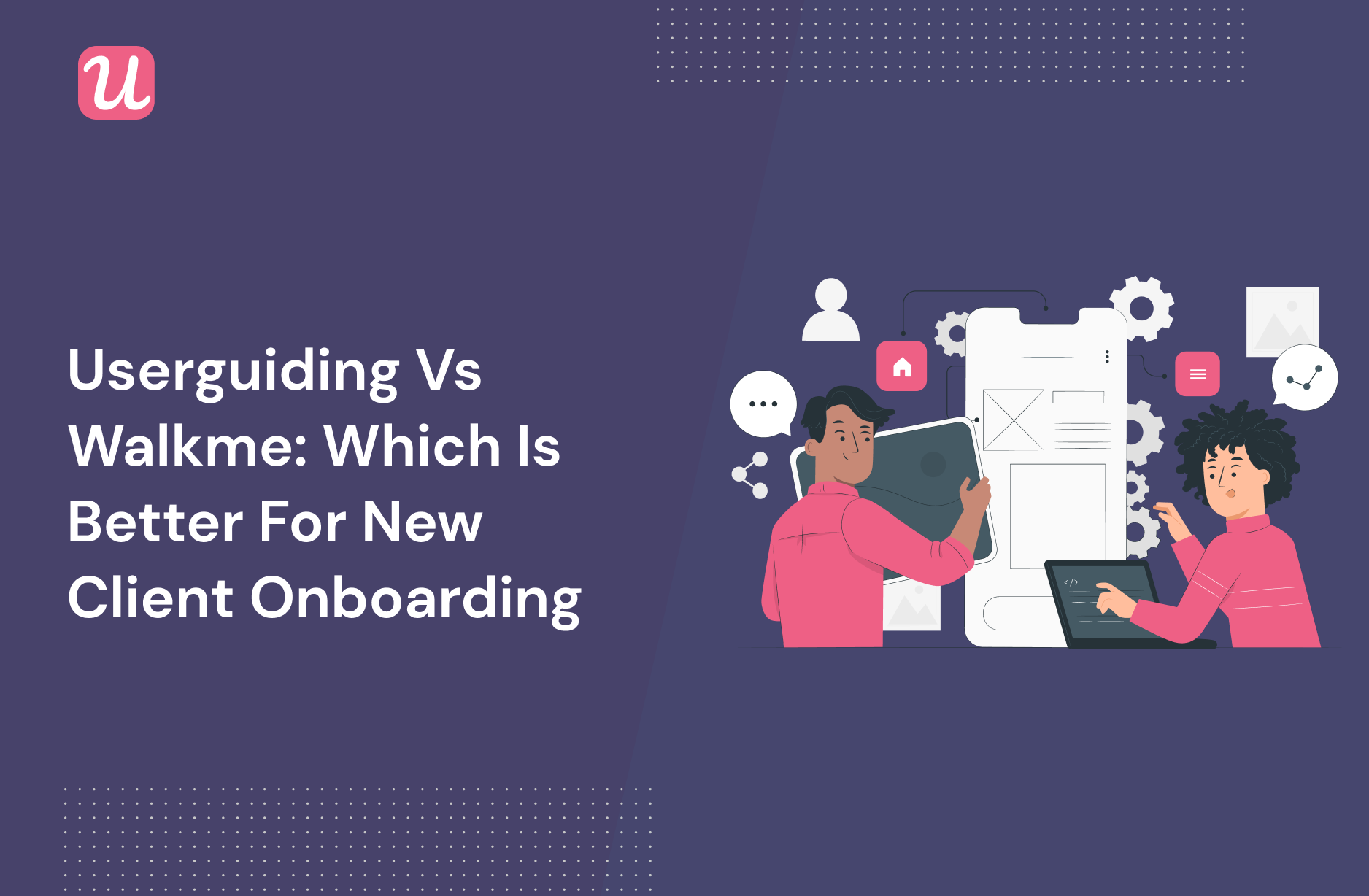
What is the best tool for onboarding new clients? Userguiding or Walkme? Would there be a better in-app onboarding software that would work better for you?
Review sites offer so many options that it’s hard to decide which is best.
Think about what features you’ll need from the tool and what your priorities are. Additionally, the price needs to match your budget. Right?
In this post, we’ll discuss exactly that – what the perfect tool for new client onboarding should deliver and which will be the best choice for your company’s needs.
Let’s dive in!
TL;DR
- A new client onboarding process involves welcoming new customers, answering their questions, and helping them understand the company or product.
- Onboarding is an imperative phase for SaaS companies, as it determines whether new customers stay or leave.
- Using an onboarding tool will help you create a great first impression and ensure a smooth onboarding process for your users. With this, you can create interactive walkthroughs for customers and personalize their journey based on segmentation, as well as send microsurveys to obtain feedback and measure customer satisfaction.
- Userguiding and Walkme are user onboarding tools that allow you to build product tours and interactive walkthroughs to onboard new customers.
- Though both are good tools in a SaaS market, they are not the right fit for everyone. Speaking about the main drawbacks, Userguiding’s Basic plan is very limited and you get a few features with watermark/branding. It also has bugs and performance issues quite often.
- When it comes to Walkme, there is a steep learning curve and the pricing is high as it’s mostly used by enterprise companies.
- There is a better alternative for Userguiding and Walkme. To get more value for your money, try considering Userpilot. It’s a code-free user onboarding tool that offers you a wide range of UI patterns to create interactive and personalized onboarding experiences for new customers. You will also be offered powerful segmentation and analytics functionality to better understand and serve your customers.
Looking for the best tool for new client onboarding? Search no more!

What is new client onboarding?
New client onboarding is a process that involves welcoming new clients, answering their questions, and ensuring they understand what your company offers. It’s usually delivered by Customer Success Managers for high-touch “white glove”client onboarding and may be automated for lower-ACV prosumer customers e.g. in SaaS.
Either way, it’s the time when your company establishes the relationship with your new client/customer, so it’s critical to get things right.
New clients might feel stressed about the onboarding time, wondering about the amount of time it will take them to truly understand and adopt your service/product, and feeling buyer’s remorse – whether they made the right choice and that you’re worth their time and money.
On the flip side, your customer success agents don’t know what the cooperation with the new client will be like, what are the client’s goals, and if it will be really possible to meet their expectations.
Let’s dive deeper into why new client onboarding is important, and how to get it right!
Why should you care about new client onboarding?
The new client onboarding phase is like the first date you may have with a new “romantic interest” – it’s a make-or-break few hours that determine if the next date is going to happen. Likewise, client onboarding may not last long, but it sets the stage for your whole relationship with that client.
Here’s why it’s so critical:
- The onboarding stage is a deciding factor for a lot of your clients whether to continue business with your company or not. According to Hubspot, 63% of customers consider the onboarding process when making a purchase.
- And no wonder – as the first interactions with your team, and whether there’s a lot of friction in the onboarding process or not – determine how your client perceives your company’s service level.
- Based on that, they would probably recommend your product/service to their friends or…not. So client onboarding also affects your Word of Mouth (WOM)
- This means that a bad client onboarding experience will likely leave you with poor reviews. And reviews on review sites like G2 or Capterra are an important deciding factor for most prospects considering your tool.
- Last but not least – the client onboarding phase affects the churn likelihood of your clients. If the goals are not set right in the onboarding phase, the expectations are not managed, and your client does not feel like they are reaching success – they will be more likely to feel disappointed in your product and churn.
Why do you need tools for new client onboarding?
Wondering why you even need a new client onboarding tool? There are several reasons why you may need one:
Let’s face it: you can’t provide a premium onboarding service to every client by hand, especially if you’re growing rapidly, and you’re selling to several client sectors.
And yet – considering what we discussed in the ‘importance of client onboarding’ – you really cannot afford to drop the ball on your ‘smaller’ users. So what can you do? To conduct new client onboarding well and reduce the friction for your new clients, you need the right onboarding tools
Here’s what the right new client onboarding tool that will allow you to do:
- Provide personalized onboarding flows that will be self-serve – will reduce the time your CSMs will need to spend with your clients explaining every feature of your product.
- Segment your users by company size, role, use case, and Job-to-be-done – to make sure you can deliver the right onboarding experiences to the right person, at the right time.
- Easily conduct surveys to understand your users’ goals, motivations, expectations, JTBDs, and desired outcomes.
- Track user journeys with simple user analytics and react to any problems as they arise.
- Provide self-serve support materials right inside your product, in a resource hub.
Your new client onboarding tools will allow you to do all the above synchronously, without having to deploy an army of CSMs on every single client.
Tool’s must-have features for new client onboarding?
Before picking your new client onboarding tool, you should check if it has most of the must-have features of a good onboarding tool:
Here’s what to look for before picking your client onboarding solution:
- Great segmentation capabilities – so you can segment your new clients by size, job to be done, role, use case, etc. – but also by in-app behavior.
- Ability to create no-code microsurveys – so you can easily collect additional information about your new clients that will help you customize their onboarding flows and experience.
- Features for creating no-code in-app experiences for onboarding: onboarding flows, checklists, tooltips, and modals.
- The option to create in-app resource centers for your new clients with multimedia content hubs – including help docs, knowledge base articles, video tutorials, as well onboarding flows. The knowledge hub should be available in-app and searchable by KWs.
- User analytics to monitor new client behavior inside your product, and catch customers that are failing to achieve their goals early – to offer them more personalized “human” support.
Userguiding for new client onboarding
UserGuiding is a lower-cost, entry-level product adoption tool offering a range of features to help companies onboard new customers and boost product adoption.
UserGuiding excels at building simple onboarding experiences for users. It includes a no-code builder, segmentation options, and easily added UI patterns like hotspots, tooltips, and modals.
Although it also has some other goodies like a resource center and analytics, the meat of this product is its onboarding flow builder. If all you’re looking for is a relatively easy way to build simple onboarding flows, this could be a great choice for you. However, people looking for more analytics, customization, or complex integrations should probably look elsewhere.
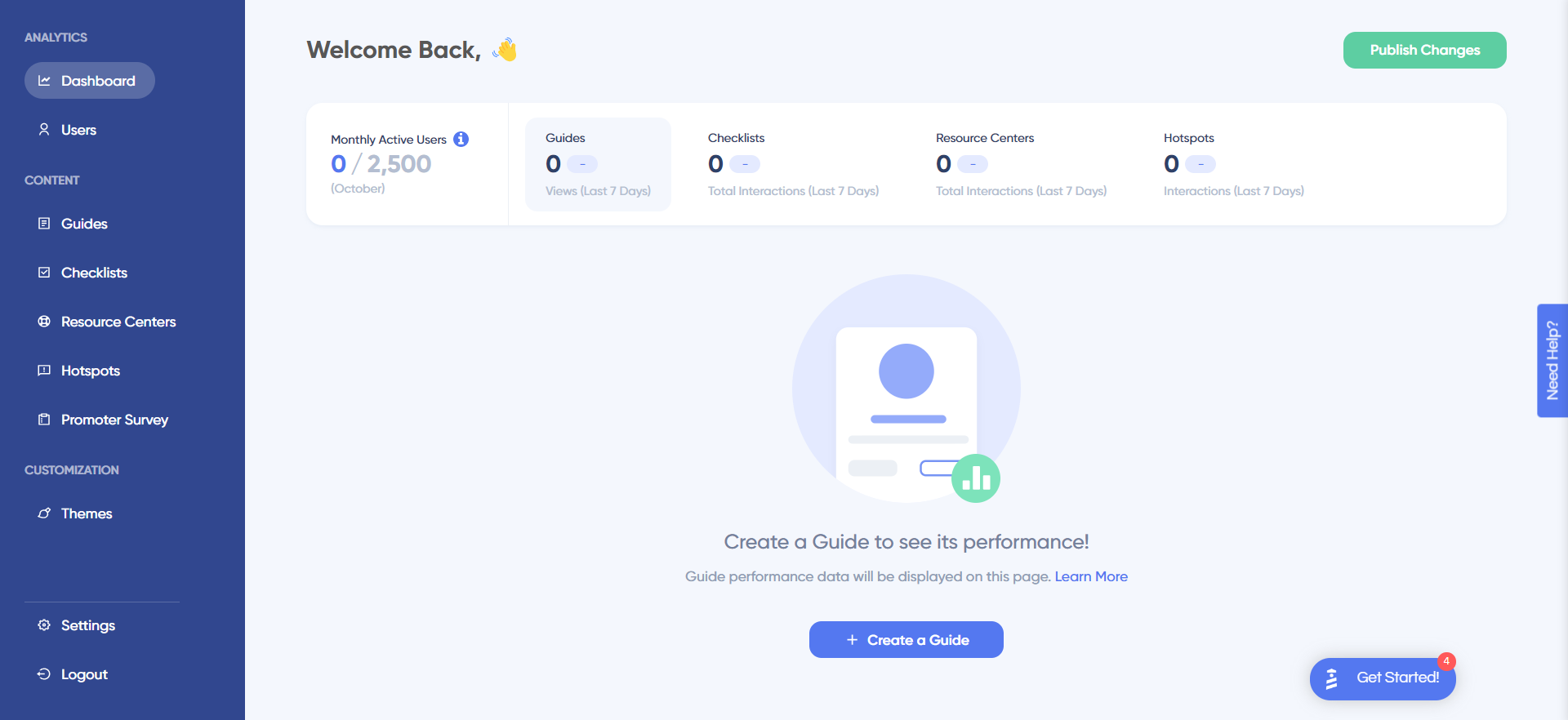
As a no-code onboarding tool, UserGuiding has numerous features that will help you create onboarding flows for your new customers and guide them throughout their journey.
Here’s what you’ll get when you start using UserGuiding:
- Create interactive product walkthroughs without disturbing your developers as it’s completely code-free.
- Build onboarding checklists and drive customers to the activation point by eliminating the guesswork on what the next step should be.
- Use a variety of UI patterns, like checklists tooltips, modals, and slideouts to prompt the right in-app experience, to the right persona, at the right time in their user journey.
- Add emojis, gifs, images, or videos to customize your onboarding flows and have them match your brand.
Though UserGuiding is a great tool for startups that don’t have much money to invest in an onboarding tool, it has very strict limitations for the Basic plan.
You can only create a maximum of 20 guides, 2 onboarding checklists, and 1 resource center. If you want to create unlimited guides with unlimited UI patterns, you should go for the Professional plan that costs $299.
Pros of Userguiding?
There are some advantages when it comes to choosing UserGuiding. Here are its pros:
- For small startups or independent businesses, the price is an attractive element to consider.
- A good variety of UI patterns to choose from when building flows and guides
- Unlike some of the more expensive options, you can choose to add a Resource Center (a bonus for self-service support).
- For a budget tool, UserGuiding still offers integrations with other applications, such as Mixpanel, Hubspot, Woopra, Slack, Webhook, etc.
Cons of Userguiding?
Though UserGuiding is a solid product many improvements are still needed. The cons of using UserGuiding include:
- There are many bugs and performance issues when using the tool. The UI is also fairly tricky to navigate.
- It has limited functionality, particularly on the basic plan. There you only have a small range of features available – all with the UserGuiding watermark/branding.
- Technical knowledge is required to get the maximum out of this product.
- Customization and design options for UI patterns aren’t the greatest.
What users say about Userguiding?
If you check the product review sites, most people like using UserGuiding.
Here are some reviews from real users:
Creating guides/checklists are easy to implement. It does not take a lot of time to make adjustments when you need to make changes.
You can go live with a simple guide or checklist within minutes. I was able to go live within a few days of getting started. – Administrator in Computer Software
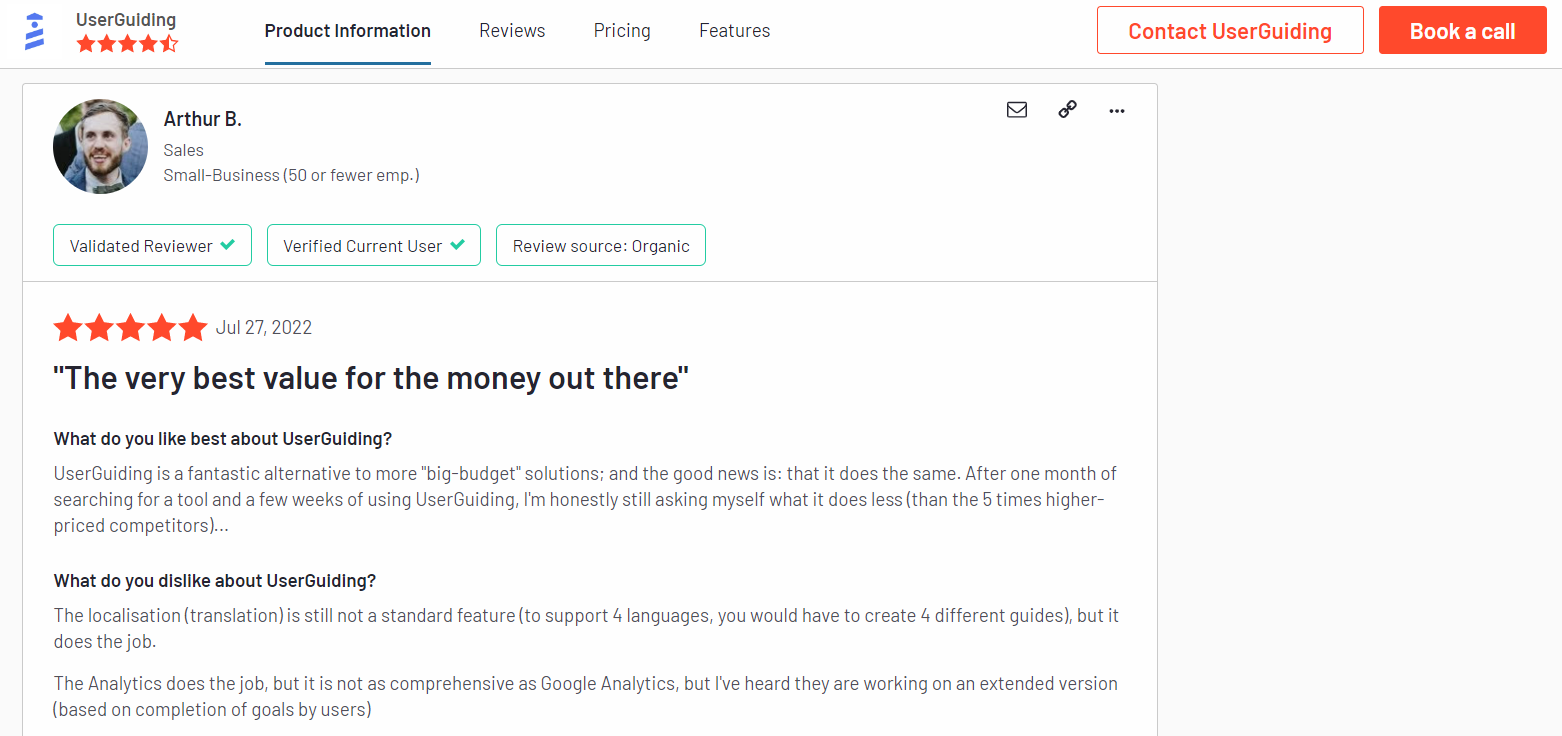
However, some people think there’s too much friction due to bugs. Let’s have a look at some negative reviews to see why users complain about:
It is a bit buggy, sometimes it lags or freezes.
And, some people think that there is still room for improvement:
The analytics felt a little elementary. Other than the Mixpanel integration, it wasn’t possible to analyze user data directly on the UserGuiding dashboard. There was an API we could use that required some set up, but this was something I expected to be baked into the product for sure.- Administrator in Computer Software
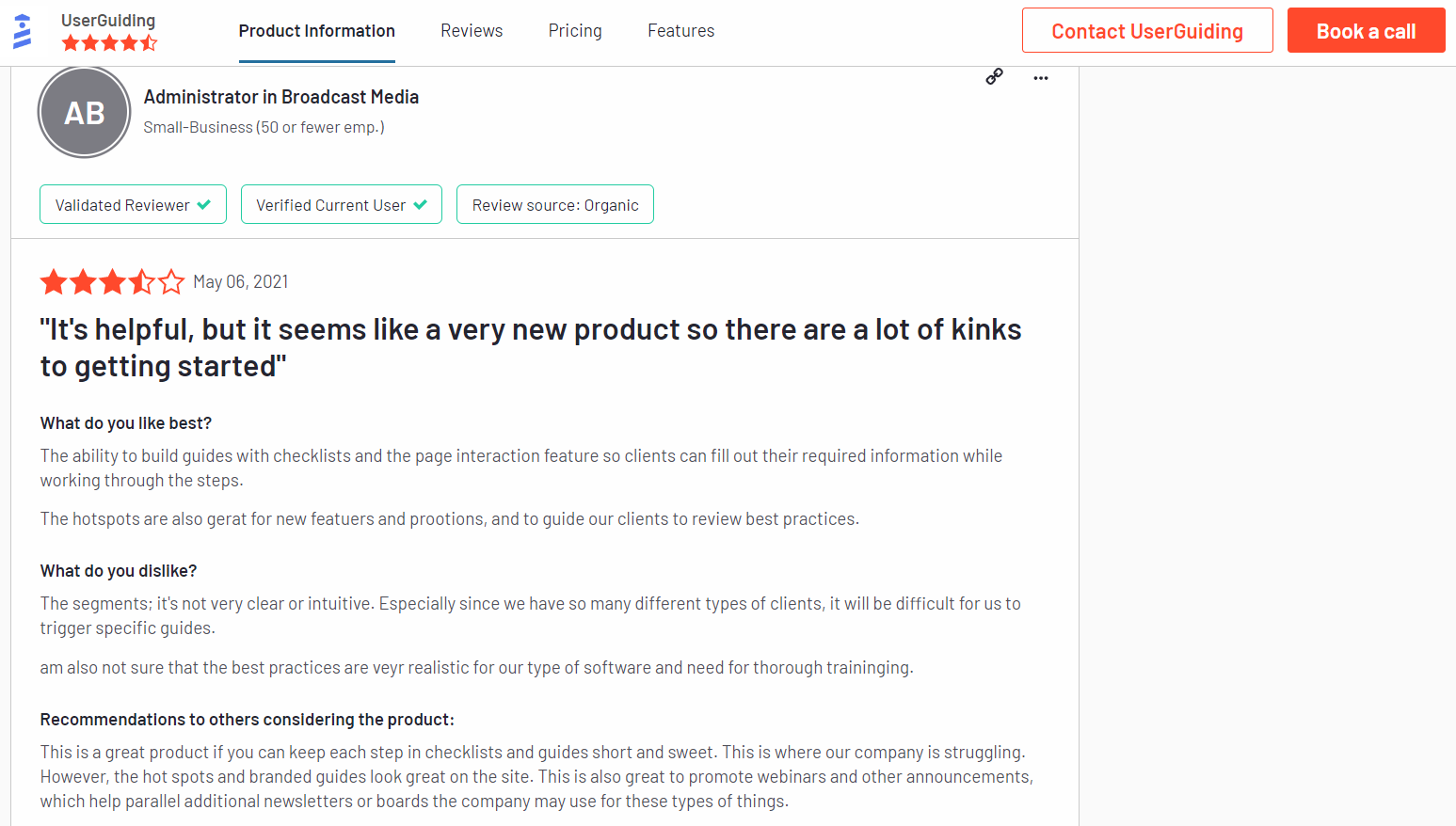
Is Userguiding the right fit for your business?
UserGuiding is a great fit for small SaaS businesses but it might be not the right fit if you want to:
- Create fully interactive product tours
- Build segments completely code-free as segmentation features aren’t very intuitive and may require additional help from a developer
- Get in-depth analytics. Though UserGuiding does have analytics functionality, it’s not complex and doesn’t give you much data.
Userguiding pricing
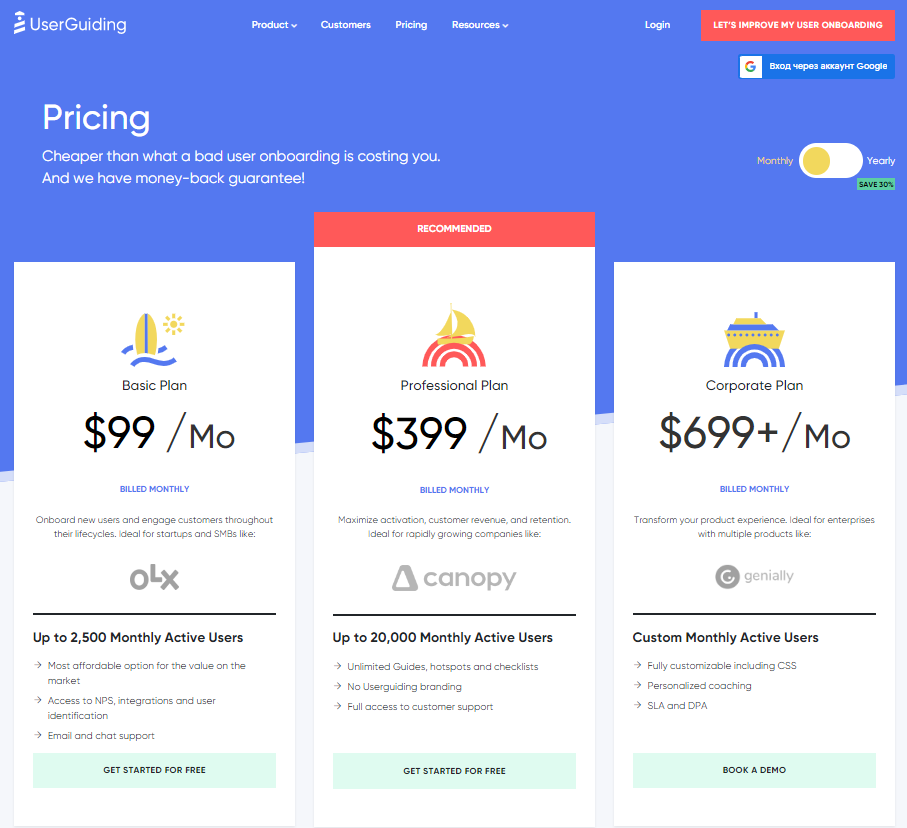
UserGuiding’s pricing model is far simpler than others on our list. There are three tiers, each one charging a set amount for access to certain tools.
Here are its packages:
- Basic will give you access to only the most essential onboarding tools: Starting at $99/mo or $69/mo (if you buy the yearly contract), this budget option has a few limitations to consider (i.e. just 1 Team Member, a limit of 20 guides, and 2 checklists, UserGuiding branding on all UI patterns).
- Professional adds unlimited guides, hotspots, and checklists. Starting at $399/mo or $299 /mo if billed yearly.
- Corporate gives you access to everything plus personalized coaching. Starting at $699/mo or $499.mo for a yearly plan.
There is a better tool for your SaaS than Userguiding!

Walkme for new client onboarding
WalkMe is one of the pioneers in the market of adoption tools. It is a cloud-based software that allows you to create product tours and in-app experiences to drive adoption faster.
WalkMe is best for enterprise companies as they are focused on employee onboarding rather than user onboarding.
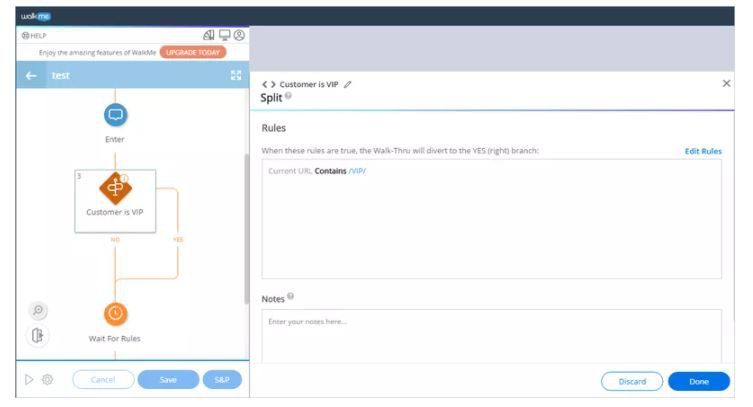
WalkMe user onboarding solution consists of 3 main guiding elements: WalkThrus, SmartTips, and ShoutOuts. These allow you to provide interactive in-app guidance to your customers.
Let’s have a quick look at each of these functionalities and how they help with user onboarding:
- WalkMe’s WalkThrus are its primary engine for creating user onboarding experiences. They overlay the target software or web app and provide on-screen guidance to help users complete tasks. In most cases, this means step-by-step instructions and tips that lead users from a starting point to the completion of a given task.
- SmartTips are also a form of on-screen guidance, but they’re less about the process and more about resolving points of friction. For example, with a SmartTip you can trigger a small note to pop up suggesting relevant links or giving more information about how to complete a form.
- ShoutOuts operate like SmartTips, but are geared toward in-product messaging. You can trigger them to pop up and give more information about relevant features, new updates, or product promotions.
- WalkMe also offers a couple of other more niche features for onboarding. For example Launchers (buttons that launch other WalkMe features or experiences), surveys, and an ActionBot (automated robo-chat to help users resolve issues and answer questions).
Pros of Walkme
WalkMe has its fair share of advantages that make it a solid tool. So what are WalkMe’s pros?
Here are our top three:
- Offers a high level of customization and works on both your own tool and 3rd party tools.
- Allows you to create in-app quizzes to test user or employee knowledge after completing a flow.
- Get access to a vast list of integrations that simply enhance your data collection or allow you to connect multiple tools in your stack.
Cons of Walkme
WalkMe is an established tool on the market but it does have its own share of cons too.
Here are the main ones you should consider:
- There’s a steep learning curve and a fair amount of technical knowledge required to create WalkMe user guides and get them implemented the way they’re intended.
- WalkMe is designed for enterprise organizations, and its pricing reflects that.
- You could end up spending anything from $9000 to $50000 a year on WalkMe. That’s a lot of money for startups and SMEs.
What users say about Walkme?
Users are mostly happy with WalkMe’s features: on-screen guidance, interactive walkthroughs, customizable UI patterns, and journey segmentation are highly used and appreciated by customers.
Here are some reviews from real users.
“The most valuable thing WalkMe provides is time. WalkMe provides the user with on-screen guidance to get them to where they need to be without weighing down support teams on training for every function. The automated steps can remove multiple clicks and quickly send the user to what they need to see. The ability to view user activity and search terms allows mapping new build requirements properly.”
“WalkMe is very user-friendly and easy to learn! There are so many different features of WalkMe to provide a customizable and creative experience for all of our users. I love creating smart walkthroughs and building flows charts, which is the most fun part of my day-to-day tasks!”
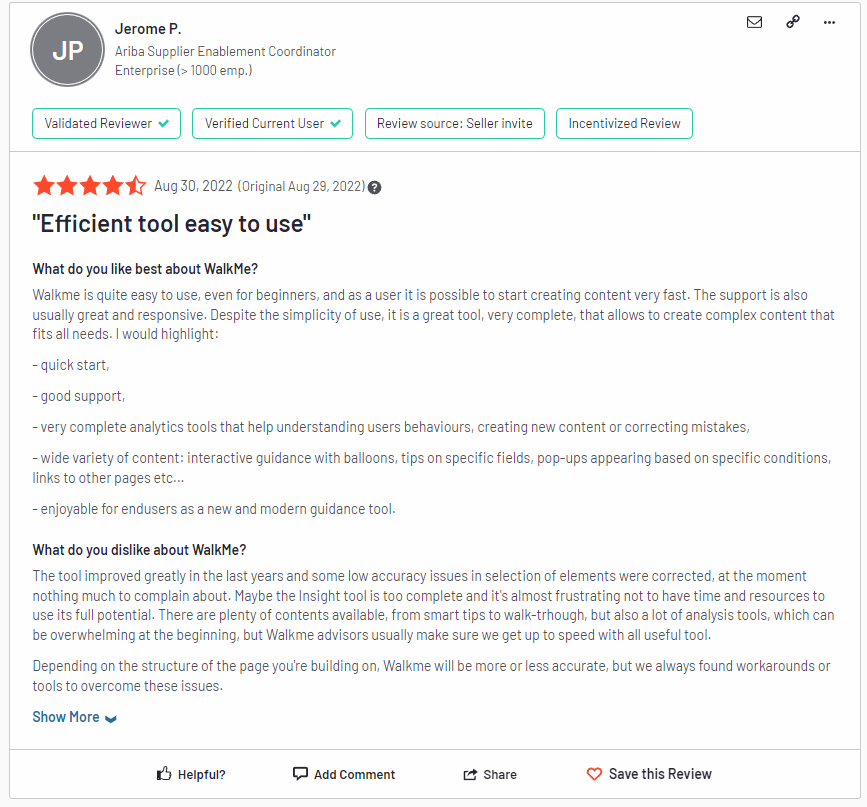
But Walkme is not a perfect solution, most complaints are about hard implementation and annual contract pricing.
Here are some words from real Walkme users:
We never had time to implement the product. It takes a huge time investment and isn’t designed for the full documentation. Rather than maintain two sets of documentation, we removed Walkme from our product. This company is as bad as AOL or TimeWarner: they will not let you out of your multi-year contract no matter how unhappy you are with the product.
The tool is not very intuitive and has countless challenges using and technical difficulties.
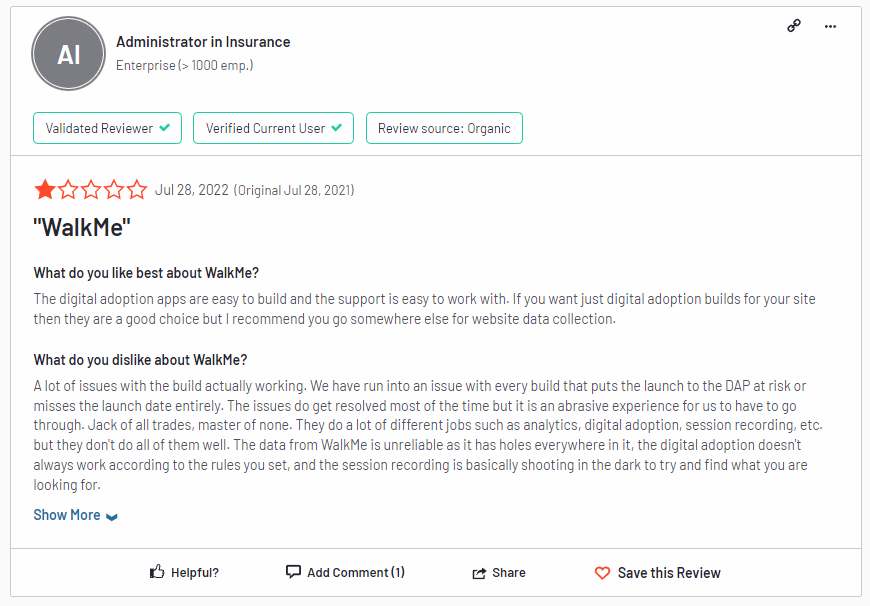
Is Walkme the right fit for your business?
Is WalkMe all you need or are there better alternatives that can provide more value at a much lower price? Here are the main reasons you should look for an alternative:
- WalkMe offers only yearly pricing contracts which start at $9000 so if you want to onboard new customers or provide in-app guidance then there are better solutions that won’t lock you in.
- WalkMe is known for its hard implementation so it’s not recommended for non-technical people. Generally, it can take weeks or even months. For better comparison, Userpilot can be set up in just a few minutes as it’s completely code-free.
- Bad and outdated UX design is another thing that might disappoint you and make you search for alternatives.
Walkme pricing
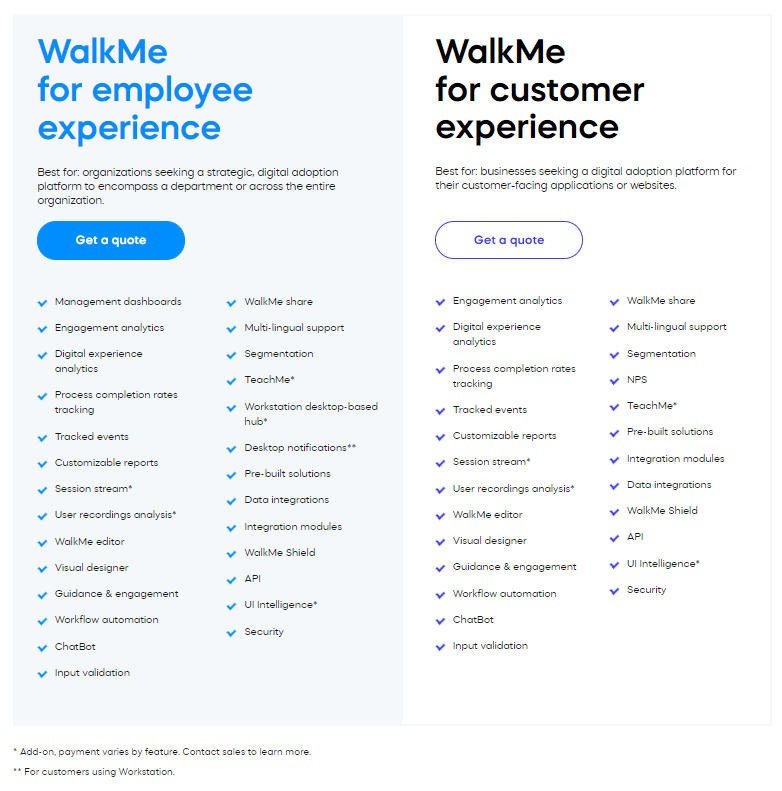
WalkMe works on a custom pricing plan that requires you to request a quote from their sales team (could be spending from $9000 to $50000 a year).
Their main two plans are:
- WalkMe for employee onboarding experience: engagement tools and analytics
- WalkMe for customer experience: engagement tools and analytics
- Add-ons: Session Streams, TeachMe, AI analytics through UI intelligence
There is a better tool for your SaaS than Walkme!

Is there a better alternative for new client onboarding?
Userguiding and Walkme are good tools for new client onboarding. We’ve seen how they compare to each other and what you can achieve with them. Call us biased, but if you’re looking for something better, Userpilot offers more value for your money than these tools.
Userpilot for new client onboarding
Userpilot is a powerful product adoption platform that enables you to quickly build personalized, flexible, contextually relevant in-app experiences targeted to different user segments without writing a line of code.
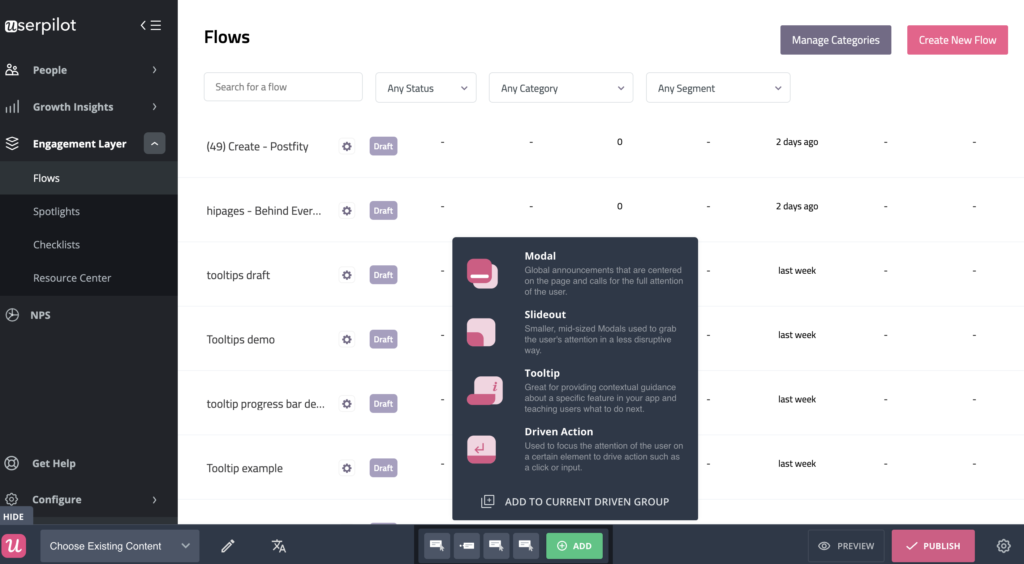
Userpilot was built specifically for SaaS product teams that want to improve their user onboarding experience and boost user activation.
You can build a huge variety of user onboarding experiences and in-app guidance flows without needing to code.
Here’s what you’ll get when you start using Userpilot:
- Forget about coding in-app experiences: Userpilot is a no-code solution and only requires your dev to install a line of javascript inside your app and for you to download a chrome extension that opens up the visual builder.
- Build in-app flows using the most extensive range of UI patterns (modals, slideouts, tooltips, hotspots, banners) and in-app onboarding experiences (checklists, microsurveys, NPS surveys, in-app resource center)
- Get access to a built-in NPS tool for collecting and analyzing user sentiment so you can improve your onboarding process based on real data.
- Create and track combinations of in-app events like clicks, hovers and form fills, and then analyze all these interactions under your own custom events, which can be built without code or API calls.
- Use advanced product analytics and in-app flows analytics to identify where users need help and create granular user segments to trigger in-app experiences contextually (segment based on user identification data, in-app engagement, custom events, clicks, hovers, form fills, user feedback responses, NPS scores and more)
- Enhance the onboarding experience with in-app help by launching a Resource Center directly inside your app. Add in-app guides, and video tutorials, and give users access to search the knowledge base or reach out to support. Self-service has never been easier.
The best user onboarding is contextual and it happens right where the users need it, inside your app. There isn’t a better user onboarding tool out there that offers more value for the money than Userpilot.
Schedule a demo with our team and get ready to build the best onboarding experiences your users have seen.
Pros of Userpilot
Userpilot has a number of advantages, especially for mid-market SaaS companies looking for a robust but at the same time very easy-to-use, a no-code tool for user onboarding, product adoption, and simplified product analytics. Let’s have a look at the pros of using Userpilot:
- No-code builder – Userpilot comes with an easy-to-use Chrome Extension builder.
- Multiple UI patterns – choose from a range of options to build customized flows: modals,
- slideouts, banners, tooltips, hotspots, and checklists are all at your disposal.
- UI patterns are not limited by plan – you get access to all of them on every single plan, meaning you get value even with the Traction plan (this is the entry-level one).
- Engaging walkthroughs and onboarding flows- build interactive walkthroughs targeted to distinct user segments.
- In-app help – build a resource center offering self-service support to your users, customize it with your branding, and select from a range of help options to boost user satisfaction (i.e. videos, in-app flows, chat, and more).
- Experimentation – built-in A/B testing for flows lets you explore and quickly iterate based on direct user behavior.
- Powerful feedback options- integrated NPS surveys with analytics and response tagging unlock insight into how your users feel.
- Advanced analytics and segmentation- analyze product usage and in-app flow engagement and build user segments using the data.
- Event tracking and feature tags- tag UI engagement (clicks, form fills, hovers) and group them into one custom event to track what really matters.
- More value with integrations- unlock value faster with built-in integrations with popular tools like Segment, Amplitude, Mixpanel, Kissmetrics, Intercom, Heap, and more.
Cons of Userpilot
Userpilot has a number of advantages, especially for mid-market SaaS companies looking for a robust but at the same time very easy-to-use, a no-code tool for user onboarding, product adoption, and simplified product analytics. Let’s have a look at the pros of using Userpilot:
- No-code builder – Userpilot comes with an easy-to-use Chrome Extension builder.
- Multiple UI patterns – choose from a range of options to build customized flows: modals,
- slideouts, banners, tooltips, hotspots, and checklists are all at your disposal.
- UI patterns are not limited by plan – you get access to all of them on every single plan, meaning you get value even with the Traction plan (this is the entry-level one).
- Engaging walkthroughs and onboarding flows- build interactive walkthroughs targeted to distinct user segments.
- In-app help – build a resource center offering self-service support to your users, customize it with your branding, and select from a range of help options to boost user satisfaction (i.e. videos, in-app flows, chat, and more).
- Experimentation – built-in A/B testing for flows lets you explore and quickly iterate based on direct user behavior.
- Powerful feedback options- integrated NPS surveys with analytics and response tagging unlock insight into how your users feel.
- Advanced analytics and segmentation- analyze product usage and in-app flow engagement and build user segments using the data.
- Event tracking and feature tags- tag UI engagement (clicks, form fills, hovers) and group them into one custom event to track what really matters.
- More value with integrations- unlock value faster with built-in integrations with popular tools like Segment, Amplitude, Mixpanel, Kissmetrics, Intercom, Heap, and more.
What users say about Userpilot

Let’s check what real users like about Userpilot.
Userpilot is an incredible, user-friendly software that allows us to create unforgettable experiences for our clients! From basic to complex experiences, we have been able to do them all with ease! I would highly recommend this software to anyone who wants to provide their clients or users with the best product tour experience. The possibilities of what you can create are endless! – Tayla G.
Userpilot is simple to set up, use, and does not require any dev – which means instant publishing. This is critical for us as a SaaS company that releases new features frequently; we need the ability to inform our customers of changes quickly, and doing this in our platform through Userpilot allows us to reach the right audience, at the right time, in the right place. There have been many awesome extra features we’ve discovered since coming on board, and it’s been great to see new features released frequently. The tool itself is intuitive and reliable. Having used similar products previously that were clunky and buggy this has really made us happy with our decision to move to Userpilot. – Melina K.
Get more value for your money with Userpilot!

Userpilot pricing
Userpilot’s transparent pricing ranges from $249/month on the entry-level end to an Enterprise tier for larger companies.
Furthermore, Userpilot’s entry-level plan includes access to all UI patterns and should include everything that most mid-market SaaS businesses need to get started.

Userpilot has three paid plans to choose from:
- Starter: The entry-level Starter plan starts at $249/month and includes features like segmentation, product analytics, reporting, user engagement, NPS feedback, and customization.
- Growth: The Growth plan starts at $749/month and includes features like resource centers, advanced event-based triggers, unlimited feature tagging, AI-powered content localization, EU hosting options, and a dedicated customer success manager.
- Enterprise: The Enterprise plan uses custom pricing and includes all the features from Starter + Growth plus custom roles/permissions, access to premium integrations, priority support, custom contract, SLA, SAML SSO, activity logs, security audit, and compliance (SOC 2/GDPR).
Conclusion
This is what you need to know. Now, you should be able to make an informed decision between Userguiding and Walkme.
Both tools have advantages and disadvantages, so there is no one that is the best. The best option would be to go with the alternative option if you want to get the most value for your money.
Would you like to see how Userpilot can help with new client onboarding? Book a demo below.
There is a better tool for your SaaS than Userguiding!


